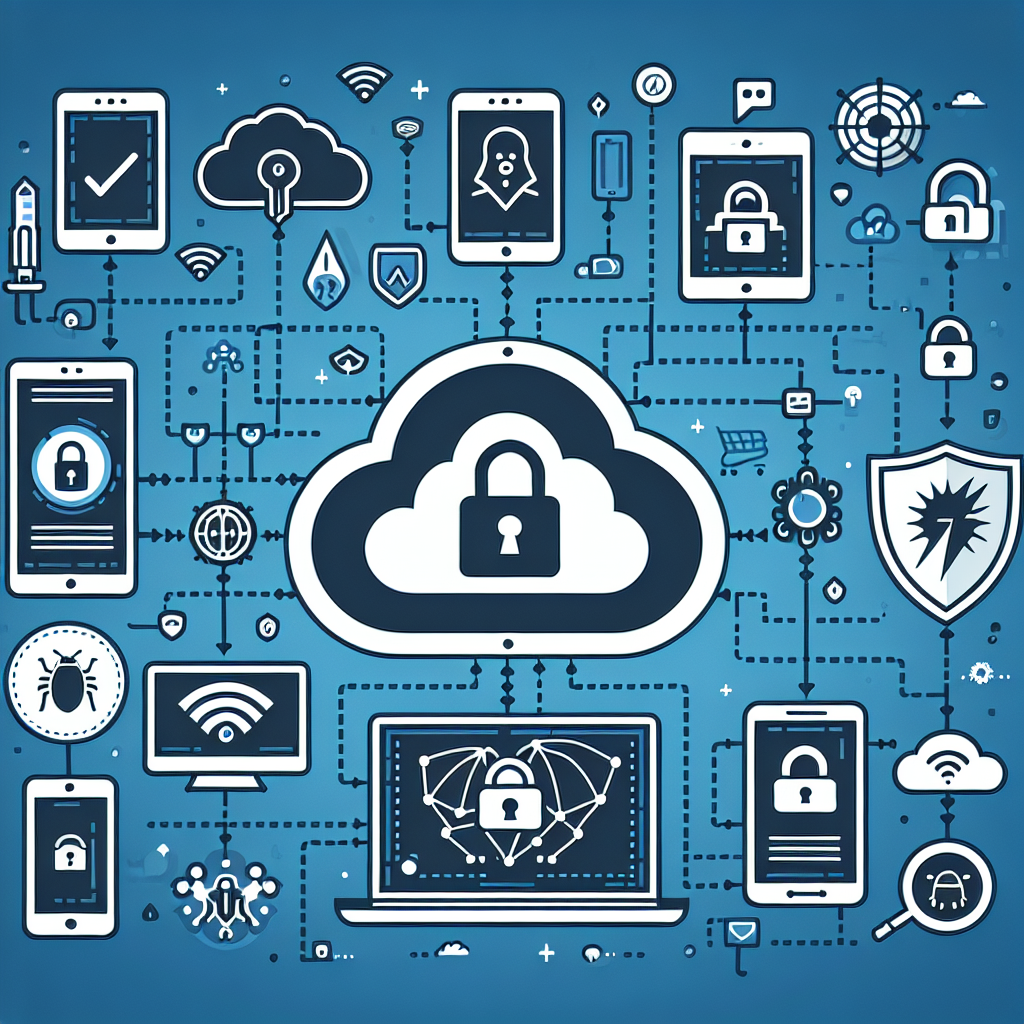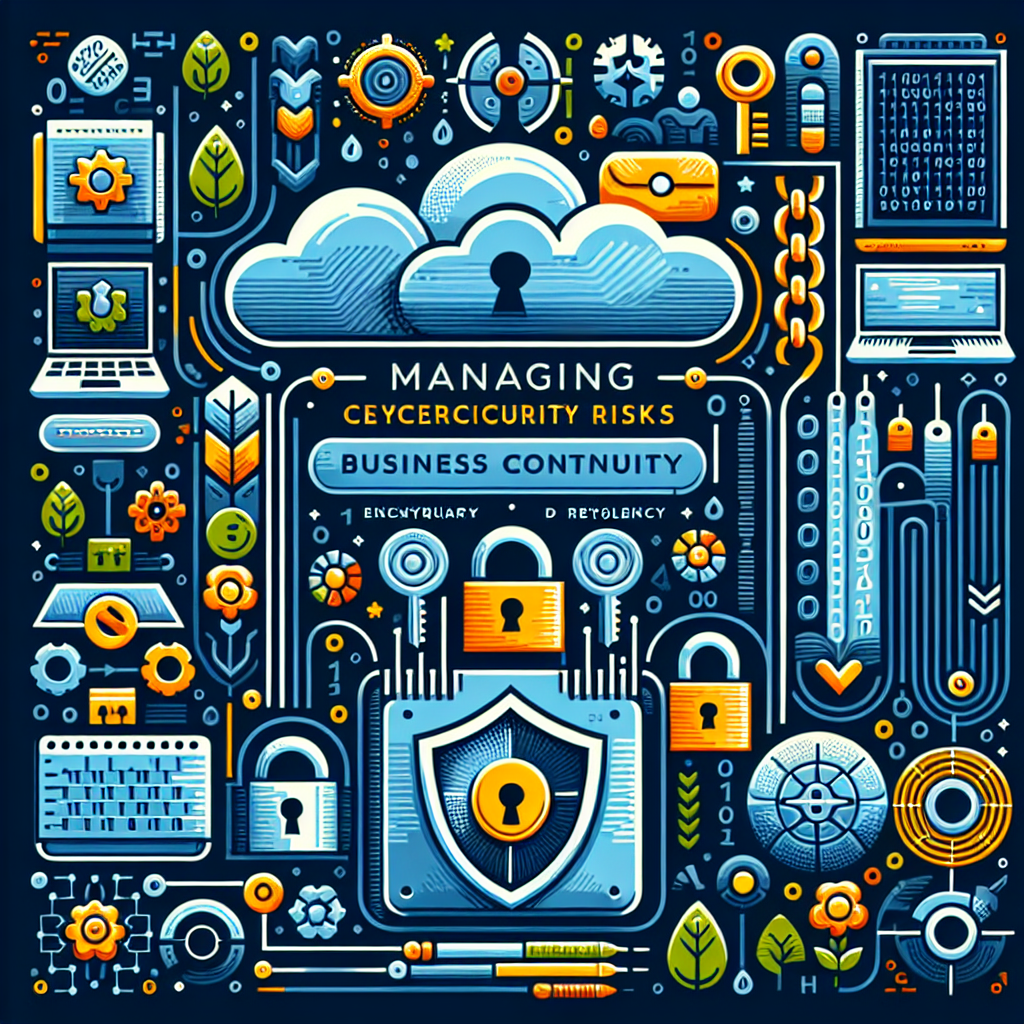Your cart is currently empty!
Tag: Risks

Understanding Cybersecurity Risks and How to Mitigate Them
In today’s digital age, cybersecurity has become a critical concern for individuals and businesses alike. With the increasing number of cyber threats and attacks, it is more important than ever to understand the risks and take proactive measures to mitigate them.One of the first steps in understanding cybersecurity risks is to recognize the various types of threats that exist. These can range from phishing attacks, where hackers use fraudulent emails to trick individuals into sharing sensitive information, to malware, which is malicious software designed to disrupt, damage, or gain unauthorized access to computer systems.
Another common threat is ransomware, where hackers encrypt a victim’s files and demand payment in exchange for the decryption key. Other risks include insider threats, where employees or contractors intentionally or unintentionally compromise security, and denial-of-service attacks, where hackers overwhelm a system with traffic to disrupt its normal functioning.
To mitigate these risks, it is essential to implement robust cybersecurity measures. This can include using strong, unique passwords for all accounts, enabling two-factor authentication, keeping software and systems up to date with the latest security patches, and using antivirus software to detect and remove malware.
Additionally, organizations should conduct regular security assessments and audits to identify vulnerabilities and weaknesses in their systems. Training and educating employees on cybersecurity best practices can also help prevent human error and reduce the likelihood of a successful attack.
It is also crucial to have a response plan in place in case of a security breach. This can include isolating affected systems, notifying relevant authorities, and restoring data from backups. Having a well-defined incident response plan can help minimize the impact of a cyber attack and enable a swift recovery.
In conclusion, understanding cybersecurity risks and taking proactive measures to mitigate them is essential in today’s digital landscape. By staying informed about the latest threats, implementing robust security measures, and having a response plan in place, individuals and organizations can better protect themselves against cyber attacks and safeguard their sensitive information.

Risks of Neglecting Disaster Recovery: The Cost of Not Being Prepared
Disasters can strike at any time, whether it be a natural disaster like a hurricane or earthquake, or a man-made disaster like a cyber attack or a fire. It is crucial for businesses to have a disaster recovery plan in place to ensure they can quickly recover and resume operations in the event of a disaster. However, many businesses neglect disaster recovery planning, thinking that it is an unnecessary expense or that it won’t happen to them. But the risks of neglecting disaster recovery can be costly, both financially and in terms of reputation.One of the biggest risks of neglecting disaster recovery is the financial cost. Disasters can cause significant damage to a business, including loss of data, equipment, and facilities. Without a disaster recovery plan in place, businesses may struggle to recover from the disaster and could face huge financial losses. In fact, according to the Federal Emergency Management Agency (FEMA), 40% of businesses do not reopen after a disaster, and of those that do, 25% fail within one year. This highlights the importance of having a solid disaster recovery plan in place to protect your business from financial ruin.
Another risk of neglecting disaster recovery is the damage to a business’s reputation. Customers and clients expect businesses to be able to quickly recover from a disaster and continue providing products and services. If a business is unable to do so due to a lack of disaster recovery planning, it can damage their reputation and lead to a loss of customers and revenue. In today’s digital age, news travels fast, and a business that is seen as unprepared for a disaster can suffer long-term damage to their reputation.
In addition to the financial and reputational risks, neglecting disaster recovery can also lead to legal and regulatory issues. Depending on the industry, businesses may be required to have a disaster recovery plan in place to comply with regulations and laws. Failure to do so can result in fines and legal action, further adding to the costs of neglecting disaster recovery.
Overall, the risks of neglecting disaster recovery are too great to ignore. Businesses that fail to have a solid disaster recovery plan in place are putting themselves at risk of financial losses, reputational damage, and legal issues. Investing in disaster recovery planning is essential for protecting your business and ensuring its survival in the face of a disaster. Don’t wait until it’s too late – take action now to prepare for the unexpected.

Weathering the Storm: How Business Continuity Planning Can Mitigate Risks and Ensure Business Stability
In today’s unpredictable business landscape, it is crucial for organizations to have a solid business continuity plan in place to weather the storm and mitigate risks. With the increasing frequency of natural disasters, cyberattacks, and other unforeseen events, businesses must be prepared to ensure business stability and continuity.Business continuity planning refers to the process of creating a strategy to ensure that essential functions and operations can continue during and after a disaster or crisis. This involves identifying potential risks, assessing their potential impact on the business, and implementing measures to reduce these risks and minimize disruptions.
One of the key benefits of business continuity planning is that it helps organizations to be better prepared for unexpected events. By identifying potential risks and vulnerabilities, businesses can develop strategies to mitigate these risks and ensure that critical functions can continue even in the face of adversity.
For example, in the event of a natural disaster such as a hurricane or earthquake, a business continuity plan can outline steps to ensure the safety of employees, secure critical data and assets, and maintain essential operations. By having a plan in place, organizations can reduce downtime, minimize financial losses, and protect their reputation.
Similarly, in the face of cyber threats such as ransomware attacks or data breaches, a business continuity plan can help organizations to quickly respond and recover from these incidents. This may involve implementing cybersecurity measures, backing up data regularly, and having a response plan in place to mitigate the impact of a cyberattack.
Moreover, business continuity planning can also help businesses to comply with regulatory requirements and industry standards. Many industries have specific requirements for disaster recovery and business continuity planning, and organizations that fail to meet these standards may face fines, legal consequences, and reputational damage.
In conclusion, business continuity planning is an essential component of risk management and organizational resilience. By identifying potential risks, developing strategies to mitigate these risks, and ensuring continuity of operations, businesses can better prepare for unexpected events and ensure business stability. In today’s fast-paced and unpredictable business environment, having a robust business continuity plan is not just a good practice – it is a necessity for long-term success and sustainability.

The Risks of Not Having a Data Backup and Recovery Plan in Place
In today’s digital age, data is essential for businesses to operate efficiently and effectively. From customer information to financial records, companies rely heavily on their data to make informed decisions and drive growth. However, many businesses fail to recognize the importance of having a data backup and recovery plan in place, putting themselves at risk of losing valuable information.One of the biggest risks of not having a data backup and recovery plan in place is the potential for data loss. Whether it’s due to a cyber-attack, hardware failure, or human error, data loss can have a significant impact on a business’s operations. Without a backup plan in place, companies may struggle to recover lost data, resulting in downtime, lost revenue, and damaged reputation.
Furthermore, the cost of data loss can be substantial. According to a report by EMC, data loss and downtime cost businesses around $1.7 trillion annually. This includes the cost of lost productivity, recovery efforts, and potential legal fees. By implementing a data backup and recovery plan, businesses can minimize the financial impact of data loss and ensure business continuity in the event of a disaster.
Additionally, failing to have a data backup and recovery plan in place can also put businesses at risk of non-compliance with regulations such as GDPR and HIPAA. These regulations require businesses to protect sensitive data and have measures in place to recover lost information. Failure to comply with these regulations can result in hefty fines and damage to a company’s reputation.
To mitigate these risks, businesses must prioritize the implementation of a data backup and recovery plan. This includes regularly backing up data to secure offsite locations, testing recovery procedures, and educating employees on best practices for data protection. By investing in a robust data backup and recovery plan, businesses can safeguard their valuable information, minimize the risk of data loss, and ensure business continuity in the face of unexpected events.
In conclusion, the risks of not having a data backup and recovery plan in place are significant and can have detrimental effects on a business’s operations and reputation. It is essential for businesses to prioritize data protection and invest in a comprehensive backup and recovery plan to mitigate these risks and safeguard their valuable information. By taking proactive measures to protect their data, businesses can ensure business continuity and minimize the financial and reputational impact of data loss.

The Security Risks of Cloud Computing and How to Mitigate Them
Cloud computing has revolutionized the way businesses store and access data, allowing for greater flexibility and scalability. However, this convenience also comes with its own set of security risks that must be carefully managed to ensure the protection of sensitive information.One of the primary concerns with cloud computing is the risk of data breaches. When data is stored in the cloud, it is vulnerable to cyber attacks and unauthorized access. This can lead to the exposure of confidential information, such as customer data, intellectual property, and financial records. To mitigate this risk, businesses should implement strong encryption protocols and access controls to restrict who can view and modify data.
Another security risk associated with cloud computing is the potential for service outages and downtime. If a cloud service provider experiences a technical issue or a cyber attack, it can disrupt business operations and cause financial losses. To address this risk, businesses should have a contingency plan in place, such as regular data backups and redundancy measures, to ensure that critical systems can be quickly restored in the event of a disruption.
Furthermore, the shared nature of cloud computing means that data is stored alongside other organizations’ information on the same servers. This can create a risk of data leakage or cross-contamination if proper isolation measures are not in place. Businesses should work with their cloud service provider to ensure that data is securely segmented and that access controls are enforced to prevent unauthorized access to sensitive information.
In addition to these security risks, businesses must also consider compliance and regulatory requirements when using cloud computing services. Depending on the industry and geographic location, there may be specific data protection laws that dictate how data should be stored and managed. Failure to comply with these regulations can result in hefty fines and reputational damage. To mitigate this risk, businesses should carefully vet cloud service providers to ensure they have the necessary certifications and compliance measures in place.
Overall, while cloud computing offers many benefits, it is essential for businesses to be aware of the security risks and take proactive measures to mitigate them. By implementing robust security protocols, contingency plans, and compliance measures, businesses can confidently harness the power of cloud computing while safeguarding their sensitive information.

Business Continuity in the Digital Age: Adapting to New Challenges and Risks
In today’s digital age, businesses face a myriad of challenges and risks that can impact their operations and bottom line. From cyber attacks and data breaches to natural disasters and supply chain disruptions, the need for effective business continuity planning has never been more critical.Business continuity refers to the ability of an organization to continue operating in the face of unexpected events or disruptions. This includes having plans and protocols in place to ensure that essential functions and services can be maintained, even in the event of a crisis. In the digital age, where technology plays a central role in most businesses, the need for robust business continuity strategies is even more pronounced.
One of the key challenges that businesses face in the digital age is the threat of cyber attacks. With the increasing reliance on digital systems and data, businesses are more vulnerable than ever to cyber threats such as ransomware, phishing attacks, and malware. A successful cyber attack can not only disrupt operations but also result in significant financial losses and damage to a company’s reputation.
To mitigate the risks of cyber attacks, businesses must implement strong cybersecurity measures and develop comprehensive incident response plans. This includes regular security assessments, employee training, and the use of advanced security technologies to detect and respond to threats in real-time. By proactively addressing cybersecurity risks, businesses can minimize the impact of cyber attacks and ensure that critical systems remain operational.
Another challenge that businesses face in the digital age is the increasing complexity of their IT infrastructure. With the adoption of cloud computing, mobile devices, and IoT technologies, businesses are now managing a diverse and interconnected network of systems and devices. While these technologies offer numerous benefits, they also introduce new vulnerabilities and potential points of failure.
To address these challenges, businesses must develop comprehensive IT disaster recovery plans that account for the unique risks associated with their digital infrastructure. This includes conducting regular backups of critical data, implementing redundancy and failover mechanisms, and testing the resilience of their systems through simulated disaster scenarios. By taking a proactive approach to IT disaster recovery, businesses can minimize downtime and ensure that their operations remain uninterrupted in the face of disruptions.
In addition to cyber threats and IT infrastructure challenges, businesses must also contend with other risks such as natural disasters, supply chain disruptions, and regulatory compliance issues. These risks can have a significant impact on a company’s operations and financial stability, making it essential for businesses to have robust business continuity plans in place.
By adapting to the new challenges and risks of the digital age, businesses can ensure that they are well-prepared to respond to unexpected events and disruptions. This includes investing in cybersecurity measures, developing comprehensive IT disaster recovery plans, and implementing strategies to address other potential risks to their operations. By prioritizing business continuity, businesses can safeguard their operations, protect their assets, and maintain their competitive edge in an increasingly digital and interconnected business environment.
AI tool predicts health risks in aged care, improving resident outcomes
Listen to article An AI-powered tool developed by Telstra Health and RMIT University is transforming the way aged care facilities monitor and manage residents’ health by predicting risks such as falls, depression, and mortality.
With nearly half a million older Australians relying on aged care services as of June 30, 2023, the sector faces immense pressure to provide high-quality care.
In response, the collaboration between Telstra Health, RMIT University, and the Digital Health Cooperative Research Centre has resulted in an AI-driven tool designed to predict health risks and improve care outcomes in aged care settings.
Dr. Tabinda Sarwar, the project lead and data scientist from RMIT University, highlights the significance of the tool in alleviating the strain on nursing staff.
“The tool is capable of automatically monitoring both structured and free-text electronic patient records for 36 evidence-based indicators of deterioration,” Dr. Sarwar explains. “These indicators help predict various health risks, supporting nursing staff and improving resident care.”
Aged care nursing staff juggle numerous responsibilities, including daily caregiving and health monitoring.
Given the heavy workload, manual screening tools are not always practical. The new digital health tool is designed to reduce this burden by predicting adverse health events before they occur, making it a game-changer for aged care facilities.
The tool, which has won the 2024 Research Australia’s Digital & Data Health Innovation Award, analyzes daily operational data, including health-related notes and records.
Using advanced natural language processing (NLP) and machine learning techniques, the tool generates predictive alerts for potential health risks like falls, depression, and even mortality.
“By applying advanced data analysis to daily-collected information, we are able to predict signs of deterioration, giving care teams more time to respond,” Dr. Sarwar says. “This includes assessing risks such as falls, depression, and mortality based on data extracted from geriatric assessments, observation charts, and progress notes.”
The collaboration leveraged Telstra Health’s Clinical Manager system, which is already deployed in over 360 facilities across Australia, ensuring a broad reach.
The project also benefited from the expertise of nursing staff and the support of the Digital Health CRC, bridging the gap between academia and industry to create a highly effective solution.
Developing a universal tool that could address diverse challenges faced by nursing staff across different aged care facilities was a significant hurdle. “We had to design a solution that could have a meaningful impact on a larger population,” Dr. Sarwar explains.
To ensure the tool’s usability, the team conducted independent studies, using statistical and machine learning techniques to validate its performance and clinical feasibility.
The tool is currently being rolled out by Telstra Health, with several aged care homes already expressing interest in adopting it.
While its potential for expansion is significant, including applications in hospitals and other healthcare settings, the next steps depend on Telstra Health’s future strategies.
“This tool has the potential to extend to various healthcare settings and could play a key role in transforming the healthcare industry,” Dr. Sarwar concludes, emphasizing the wide-reaching impact of this AI-driven solution in improving healthcare outcomes for vulnerable populations.
AI tool predicts health risks in aged care, improving resident outcomesA groundbreaking AI tool is revolutionizing the way healthcare professionals in aged care facilities can predict and prevent health risks among residents. By analyzing vast amounts of data, including medical records, vital signs, and even social interactions, this AI tool can identify trends and patterns that may indicate potential health issues before they escalate.
This innovative technology allows caregivers to proactively address health concerns, leading to better resident outcomes and improved quality of life. By predicting health risks early on, healthcare providers can intervene sooner, provide targeted care, and prevent unnecessary hospitalizations or complications.
Additionally, the AI tool can help optimize care plans and personalized interventions for each resident, ultimately enhancing their overall well-being and longevity. With access to real-time insights and predictive analytics, aged care facilities can deliver more proactive and efficient care, ultimately improving resident satisfaction and outcomes.
Overall, the implementation of this AI tool in aged care facilities represents a significant step forward in leveraging technology to enhance the quality of care for older adults. By harnessing the power of artificial intelligence, healthcare professionals can better anticipate and address health risks, ultimately leading to improved resident outcomes and a higher standard of care.
Tags:
- AI tool in aged care
- Predictive health risks
- Improving resident outcomes
- Healthcare technology
- Artificial intelligence in senior care
- Elderly health predictions
- AI for improved aging outcomes
- Predictive analytics in aged care
- Health risk assessment tool
- Senior care technology advancements
#tool #predicts #health #risks #aged #care #improving #resident #outcomes

Ensuring Business Continuity in a Digital Age: Strategies for Managing Cybersecurity Risks
In today’s digital age, businesses rely heavily on technology to operate efficiently and effectively. However, with the increasing reliance on digital platforms comes the heightened risk of cybersecurity threats. From data breaches to ransomware attacks, businesses face a multitude of risks that can disrupt operations and compromise sensitive information.Ensuring business continuity in a digital age requires a proactive approach to managing cybersecurity risks. By implementing robust security measures and developing a comprehensive cybersecurity strategy, businesses can protect themselves from potential threats and minimize the impact of cyber incidents.
One of the key strategies for managing cybersecurity risks is to conduct regular risk assessments. By identifying potential vulnerabilities and threats, businesses can develop targeted security measures to mitigate risks and strengthen their defenses. This includes conducting penetration testing, vulnerability scans, and security audits to identify and address weaknesses in their systems.
Additionally, businesses should invest in security tools and technologies that can help protect their data and systems from cyber threats. This includes implementing firewalls, endpoint protection software, and intrusion detection systems to monitor and respond to suspicious activities in real-time. Businesses should also consider implementing multi-factor authentication, encryption, and access controls to enhance security and protect sensitive information.
Another important aspect of managing cybersecurity risks is employee training and awareness. Employees are often the weakest link in a company’s security posture, as they may inadvertently click on malicious links or download infected files. By providing regular cybersecurity training and promoting a culture of security awareness, businesses can empower their employees to recognize and respond to potential threats effectively.
In the event of a cyber incident, businesses should have a robust incident response plan in place to minimize the impact of the attack and ensure business continuity. This includes establishing clear roles and responsibilities, setting up communication channels, and conducting regular drills and exercises to test the effectiveness of the plan.
Overall, ensuring business continuity in a digital age requires a proactive and comprehensive approach to managing cybersecurity risks. By implementing robust security measures, conducting regular risk assessments, and investing in employee training and awareness, businesses can protect themselves from potential threats and maintain operations in the face of cyber incidents. By prioritizing cybersecurity and staying vigilant against evolving threats, businesses can safeguard their data, systems, and reputation in an increasingly digital world.

Mitigating Risks in IT Outsourcing: Best Practices for Businesses
In today’s fast-paced and competitive business environment, many companies are turning to IT outsourcing as a way to reduce costs, increase efficiency, and access specialized skills and expertise. However, while outsourcing can offer numerous benefits, it also comes with its fair share of risks. From data breaches to communication breakdowns, there are a number of potential pitfalls that businesses need to be aware of when outsourcing their IT functions.To help mitigate these risks, it is essential for businesses to follow best practices when selecting and working with outsourcing partners. By taking proactive measures and implementing robust processes, businesses can minimize the likelihood of experiencing negative outcomes and maximize the benefits of IT outsourcing. Here are some key best practices that businesses should consider when outsourcing their IT functions:
1. Conduct thorough due diligence: Before entering into a contract with an outsourcing partner, businesses should conduct a comprehensive assessment of the vendor’s capabilities, experience, and reputation. This includes reviewing references, conducting site visits, and verifying the vendor’s compliance with relevant regulations and industry standards.
2. Define clear expectations and requirements: It is essential for businesses to clearly define their expectations and requirements for the outsourcing relationship, including service levels, performance metrics, and deliverables. This can help prevent misunderstandings and ensure that both parties are on the same page from the outset.
3. Establish strong communication channels: Effective communication is key to successful outsourcing relationships. Businesses should establish regular communication channels with their outsourcing partners, including regular meetings, progress reports, and feedback sessions. This can help build trust and ensure that any issues or concerns are addressed in a timely manner.
4. Implement robust security measures: Data security is a top concern for businesses when outsourcing IT functions. To mitigate the risk of data breaches and cyber attacks, businesses should implement robust security measures, such as encryption, access controls, and regular security audits. It is also important to ensure that the outsourcing partner complies with relevant data protection regulations.
5. Monitor performance and outcomes: To ensure that the outsourcing relationship is delivering the expected benefits, businesses should monitor the performance and outcomes of the outsourcing partner on an ongoing basis. This can involve tracking key performance indicators, conducting regular reviews, and soliciting feedback from internal stakeholders.
By following these best practices, businesses can mitigate the risks associated with IT outsourcing and maximize the potential benefits. With careful planning, clear communication, and strong security measures in place, businesses can build successful and sustainable outsourcing relationships that drive innovation, efficiency, and growth.

Cybersecurity Risks in Remote Work Environments
In recent years, remote work has become increasingly popular, with many companies allowing employees to work from home or other off-site locations. While this flexibility can be a great benefit for both employees and employers, it also comes with its own set of cybersecurity risks.One of the biggest cybersecurity risks in remote work environments is the use of unsecured networks. When employees are working from home or other remote locations, they may be using public Wi-Fi networks that are not secure. These networks are vulnerable to cyberattacks, such as man-in-the-middle attacks, where hackers intercept communications between the employee’s device and the company’s network.
Another risk is the use of personal devices for work purposes. Many employees use their personal laptops, tablets, or smartphones to access company data and systems while working remotely. These devices may not have the same level of security as company-issued devices, making them more susceptible to malware and other cyber threats.
Phishing attacks are also a common risk in remote work environments. Hackers may send malicious emails or messages to employees, tricking them into clicking on a link or downloading a file that contains malware. With employees working remotely, they may be more likely to fall for these scams, as they are not able to quickly verify the legitimacy of the sender.
To mitigate these cybersecurity risks in remote work environments, companies should implement strong security measures. This includes providing employees with company-issued devices that are equipped with security software, such as antivirus and encryption tools. Employees should also be trained on cybersecurity best practices, such as how to recognize phishing emails and how to securely connect to company networks.
Companies should also implement multi-factor authentication for accessing company systems and data, to add an extra layer of security. Additionally, they should regularly update their security policies and protocols to address the changing cybersecurity landscape.
In conclusion, while remote work offers many benefits, it also presents cybersecurity risks that companies must address. By implementing strong security measures and ensuring that employees are educated on cybersecurity best practices, companies can protect their data and systems from cyber threats in remote work environments.
